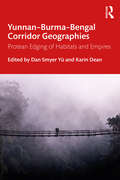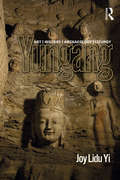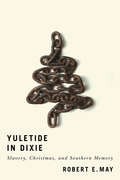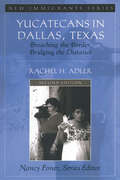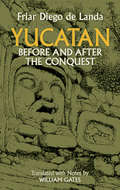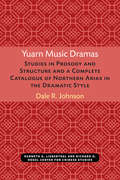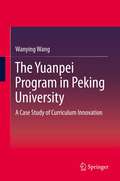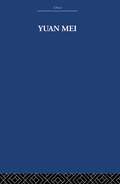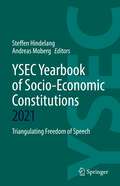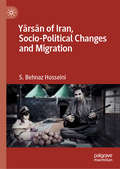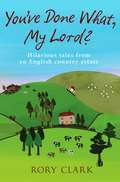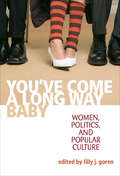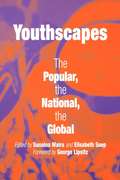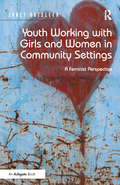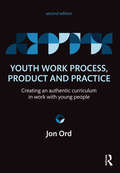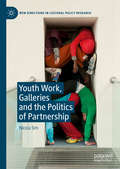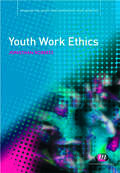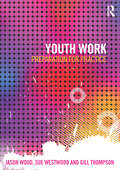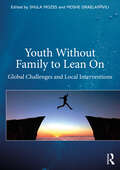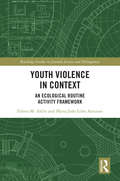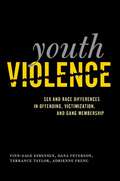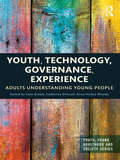- Table View
- List View
Yunnan–Burma–Bengal Corridor Geographies: Protean Edging of Habitats and Empires
by Dan Smyer Yü Karin DeanThis book explores the historical interconnections between Bengal, Burma, and Yunnan (China), and views the corridor as a transregion that exhibits mobility, connectivity and diversity as well as place-based ecogeological uniqueness. With a focus on the concept of corridor geographies that have shared human and environmental histories beyond sharply demarcated territorial sovereignties of modern individual nation-states, it presents the variety and complexity of premodern and modern pathways, corridors, borders, and networks of livelihood-making, local political alliances, trade and commerce, religions, political systems, and colonial encounters. The book discusses crucial themes including environmental edgings of human-nonhuman habitats, transregional migratory routes and habitats of megafauna, elephant corridors in Yunnan–Myanmar–Bengal landscape, framing spaces between India and China, Tibetan–Myanmar corridors, transboundary river systems, narratives of a Rohingya jade trader, cross-border flow of De’ang’s fermented tea, householding in upland Laos, cultural identities, and trans-border livelihoods. Comprehensive and topical, with its wide-ranging case studies, this book will be of interest to scholars and researchers of history, routes and border studies, sociology and social anthropology, South East Asian history, South Asian history, Chinese studies, environmental history, human geography, international relations, ecology, and cultural studies.
Yungang: Art, History, Archaeology, Liturgy
by Joy Lidu YiThe first-ever comprehensive analysis of its kind in any western language, this unique volume provides a social art history of Yungang: a 5th-century rock-cut court cave complex, UNESCO World Heritage site, and one of the greatest Buddhist monuments of all time. Yungang asks why, when, and under what circumstances this impressive cave sanctuary was made, and who played significant roles at various stages. Recent economic changes in China including the expansion of roads have led to unprecedented numbers of objects being unearthed on site and near the cave-chapels. Archaeological discoveries in 2010 have shed significant new light on the architectural configuration of monasteries in the capital and the functions of different sections of the cave complex, as well as monastic life within it. For the first time, it is possible to reconstruct where the monks lived and translated sacred literary texts, and to fully understand that freestanding monasteries are an important component of the rock-cut cave complex. Illustrated throughout with remarkable full-colour photographs, this re-examination of the cave-chapels, which brings together previous scholarship, primary documentation, and more than a decade of first-hand field research, will not only fill in the gaps in our knowledge about Yungang, but also raise, and perhaps answer, new questions in art history.
Yuletide in Dixie: Slavery, Christmas, and Southern Memory
by Robert E. MayHow did enslaved African Americans in the Old South really experience Christmas? Did Christmastime provide slaves with a lengthy and jubilant respite from labor and the whip, as is generally assumed, or is the story far more complex and troubling? In this provocative, revisionist, and sometimes chilling account, Robert E. May chides the conventional wisdom for simplifying black perspectives, uncritically accepting southern white literary tropes about the holiday, and overlooking evidence not only that countless southern whites passed Christmases fearful that their slaves would revolt but also that slavery’s most punitive features persisted at holiday time.In Yuletide in Dixie, May uncovers a dark reality that not only alters our understanding of that history but also sheds new light on the breakdown of slavery in the Civil War and how false assumptions about slave Christmases afterward became harnessed to myths undergirding white supremacy in the United States. By exposing the underside of slave Christmases, May helps us better understand the problematic stereotypes of modern southern historical tourism and why disputes over Confederate memory retain such staying power today. A major reinterpretation of human bondage, Yuletide in Dixie challenges disturbing myths embedded deeply in our culture.
Yucatecans in Dallas, Texas: Breaching the Border, Bridging the Distance
by Rachel H. AdlerThrough fascinating vignettes and case studies, this unique text illustrates how Yucatecan migrants actively maintain social ties across borders. It also paints a vivid picture of the people and their lives. It places them in the context of current U.S. immigration policy and mesmerizes students by bringing them up to speed on one of the most crucial issues facing the U.S. today.
Yucatan Before and After the Conquest (Native American)
by Diego De Landa William GatesThese people also used certain characters or letters, with which they wrote in their books about the antiquities and their sciences. We found a great number of books in these letters and since they contained nothing but superstitions and falsehoods of the devil we burned them all, which they took most grievously, and which gave them great pain.So writes Friar Diego de Landa in his Relación De las cosas de Yucatan of 1566, the basic book in Maya studies. Landa did all he could to wipe out Maya culture and civilization. In the famous auto da fé of July 1562 at Maní, as he tells us, he destroyed 5,000 "idols" and burned 27 hieroglyphic rolls. And yet paradoxically Landa's book, written in Spain to defend himself against charges of despotic mismanagement, is the only significant account of Yucatan done in the early post-Conquest era. As the distinguished Maya scholar William Gates states in his introduction, "ninety-nine percent of what we today know of the Mayas, we know as the result either of what Landa has told us in the pages that follow, or have learned in the use and study of what he told." Yucatan Before and After the Conquest is the first English translation of this very important work.Landa's book gives us a full account of Maya customs, daily activities, history, ceremonial festivals, and the many social and communal functions in which their life was expressed. Included here are the geography and natural history of Yucatan, the history of the Conquest, indigenous architecture and other aspects of Maya civilization (sciences, books, religion, etc.), native historical traditions, the Inquisition instituted by the Spanish clergy, Maya clothing, food, commerce, agriculture, human sacrifices, calendrical lore, and much more.
Yuarn Music Dramas: Studies in Prosody and Structure and a Complete Catalogue of Northern Arias in the Dramatic Style (Michigan Monographs In Chinese Studies #40)
by Dale R. JohnsonPart One of Yuarn Music Dramas presents a detailed analysis of form and structure in Yuarn music drama, with sections on the act, the suite, the aria, the verse, metrics of repeated graph patterns, parallelism, and the matching of suite and mode. [vii] Part Two presents the first catalogue of arias of its kind to be published in a language other than Chinese. It is a compilation of all of the arias in the northern dramatic style that are found in the 162 titles contained in the Yuarn-chyuu shyuann and the Yuarn-chyuu shyuaan waih-bian. It is modeled on several such catalogues compiled over the past six hundred years. [99]
The Yuanpei Program in Peking University: A Case Study of Curriculum Innovation
by Wanying WangThe Yuanpei program is an institution wide curriculum innovation, modeling on the core curriculum in Harvard which is committed to carrying out general education. This research investigated the major conflicts that arose in the process of initiation and implementation of the Yuanpei program, how these conflicts evolved during the process, and what were the sources of these conflicts. The conflict model, primarily derived from conflict theory, was adopted to interpret and analyze the process of curriculum innovation in this context. The study employed a qualitative case study approach. Data were collected primarily through interviews, observations and document analysis. The administrators, teachers and students were interviewed to gain insight into major conflicts arose, their processes and sources in process of the curriculum innovation. The researcher primarily observed program practices and operations, including program setting, the human, social environment (how participants interact and communicate), and program activities and participant behaviors. The researcher distinguished between conceptual conflicts and practical conflict in light of the different stages in which conflicts emerged. The researcher mainly identified three conceptual conflicts that represent the focus of debates: first, the two opposing opinions on how to balance between general education and specialized education; second, potential incongruence in the idea of the Yuanpei program; third, conflict between the changing need of society and traditional system of training. The researcher summarized four categories of practical conflicts in light of various issues: free-course selection, free-major selection, faculty advisor as well as general education elective courses, in each of which sub-themes were identified and analyzed. The researcher described how both conceptual and practical conflicts evolved. Each major conceptual conflict seems to go through similar stages based on the data, involving issue, confrontation and integration of claims of both sides. For practical conflicts, factors contributing to the escalation and de-escalation, moderation of conflicts were found by the researcher. The research identified different roles, incompatible values, contested resources and structural constraints as the main sources of conflict. Any conflict may involve more than one category or may be mainly due to one category. As such, the study is exploratory and contributes to the scholarship on educational change through its analysis of the curriculum innovation for general education in Peking University.
Yuan Mei: Eighteenth Century Chinese Poet (China: History, Philosophy, Economics #XXXVIII)
by Arthur Waley The Arthur EstateFirst published in 1956. Arthur Waley here presents an engrossing account of the works and life of Yuan Mei (1716-1797), the best-known poet of his time. Gaiety is the keynote of his works and the poet was a friend of the Manchu official with whom Commodore Anson had dramatic dealings at Canton in 1743. Yuan Mei gives an account (not previously translated) of Anson's interview with the Manchu authorities. The book contains many translations of Yuan Mei's verse and prose.
YSEC Yearbook of Socio-Economic Constitutions 2021: Triangulating Freedom of Speech (YSEC Yearbook of Socio-Economic Constitutions #2021)
by Steffen Hindelang Andreas MobergThis volume addresses contemporary challenges, enabled by modern technology, that concern upholding freedom of speech where it conflicts with social rights, such as respect for private and family life, and with economic rights, such as the freedom to conduct business or the right to free movement. In today’s networked world, technological shifts happen faster than most people even realize. Some of these shifts have made us all potentially powerful: media powerful. We used to sit in silence in front of newspapers and TV screens, and the world was explained to us by just a few sources. Today, thanks to the Internet, social media, and Web 2.0, we can not only share our own thoughts with everyone in a more self-determined way, but we can also take part in public debate and even co-shape it ourselves. Of course, the Internet is not a counter-design to the communication (power) structures of the past. Gains in communicative self-determination are threatened due to algorithmisation, platformisation, and value extraction from self-created private markets. At the same time, the empowerment of the individual challenges the old “grand speakers” who are suddenly detecting “fake news”, echo chambers, and filter bubbles everywhere on the Internet. Internet-based communication allegedly hinders us from the “one truth”; as if newspaper hoaxes, propaganda, and narrow-mindedness were an invention of the Internet. The current heated debate over “fake news”, copyright, and “upload filters” shows that we are unsure of how to deal with the newer and more complex phenomena of Internet-based speech. This is due in no small part to the fact that an important benchmark – our constitutional compass – is still firmly rooted in the past. Constitutions change far more slowly than technologies. Societal changes can drive constitutional changes; but what about normative content control? Today, there are already demands for “old-school clarity”: truth filters on social media platforms, horrendous sums of liability for platforms that encourage (overly)thorough cleaning up. However, it is equally true that private individuals “regulate”: they decide what is found on the Internet and who may post on a given platform. Accounting for all interests at play and striking a “fair” balance that avoids both a public and private over- and under-regulation is a complex matter. The authors of this volume not only provide reflections in their highly topical contributions, but also share their understanding of what constitutes a fair balance within the larger frame of freedom of speech in a digital age.
Yārsān of Iran, Socio-Political Changes and Migration
by S. Behnaz HosseiniThis book examines how socio-political surroundings have affected the evolution of Yārsāni religious thought and why the Yārsāni religious belief, despite its fundamental disagreement with Islamic tenets, has been affiliated with Islam. It also considers the historical context and socio-religious milieu in which the Yārsāni belief appropriates religious forces to survive, how Yārsānis experience their religion in Islamic society, and what differences are significant in their lived experiences. The author explores how the experience of worship influences real life for the Yārsānis from the perspectives of sociology, behaviorism, content analysis, cultural studies and ethnography in Iran and diaspora with focus on Sweden. Yārsāni followers became known as those who “don’t tell secrets,” primarily because they were not allowed to promote and advertise their religion in public, but recently have started to reveal their religion, especially in social media. This book discovers the transformation of this religion, and in particular in which context an individual can change the content of religion, and bring about new ideas regarding religion and belief.
You've Done What, My Lord?: Hilarious tales from a country estate
by Rory ClarkRumshott is one of the finest landed estates in England. However, when James Aden takes up the position of Deputy Agent he does not realise the full extent of what the job entails.He finds himself spending his days negotiating with royalty, farmers, and even wildlife, as well as the imperious Lady Leghorn. In order to survive, James must come to terms with his role quickly, and not let himself get too distracted by Sophie, the pre-college assistant.
You've Done What, My Lord?: Hilarious tales from a country estate
by Rory ClarkRumshott is one of the finest landed estates in England. However, when James Aden takes up the position of Deputy Agent he does not realise the full extent of what the job entails.He finds himself spending his days negotiating with royalty, farmers, and even wildlife, as well as the imperious Lady Leghorn. In order to survive, James must come to terms with his role quickly, and not let himself get too distracted by Sophie, the pre-college assistant.
You've Come A Long Way, Baby: Women, Politics, and Popular Culture
by Lilly J. GorenNo matter what brand of feminism one may subscribe to, one thing is indisputable: the role of women in society during the past several decades has changed dramatically, and continues to change in a variety of ways. In You've Come a Long Way, Baby, Lilly J. Goren and an impressive group of contributors explore the remarkable advancement achieved by American women in a historically patriarchal social and political landscape, while examining where women stand today and contemplating the future challenges they face worldwide. As comprehensive as it is accessible, You've Come a Long Way, Baby appeals to anyone interested in confronting the struggles and celebrating the achievements of women in modern society.
Youthscapes
by Sunaina Maira Elisabeth Soep George LipsitzYoung people, it seems, are both everywhere and nowhere. The media are crowded with images of youth as deviant or fashionable, personifying a society's anxieties and hopes about its own transformation. However, theories of globalization, nationalism, and citizenship tend to focus on adult actors. Youthscapes sets youth at the heart of globalization by exploring the meanings young people have created for themselves through their engagements with popular cultures, national ideologies, and global markets.The term "youthscapes" places local youth practices within the context of ongoing shifts in national and global forces. Using this framework, the book revitalizes discussions about youth cultures and social movements, while simultaneously reflecting on the uses of youth as an academic and political category. Tracing young people's movements across physical and imagined spaces, the authors examine various cases of young people as they participate in social relations; use and invent technology; earn, spend, need, and despise money; comprise target markets while producing their own original media; and create their own understandings of citizenship. The essays examine young Thai women working in the transnational beauty industry, former child soldiers in Sierra Leone, Latino youth using graphic art in political organizing, a Sri Lankan refugee's fan relationship with Jackie Chan, and Somali high school students in the United States and Canada. Drawing on methodologies and frameworks from multiple fields, such as anthropology, sociology, and film studies, the volume is useful to those studying and teaching issues of youth culture, popular culture, globalization, social movements, education, and media.By focusing on the intersection between globalization studies and youth culture, the authors offer a vital contribution to the development of a new, interdisciplinary approach to youth culture studies.
Youth Working with Girls and Women in Community Settings: A Feminist Perspective
by Janet BatsleerThis fully revised and expanded edition of Janet Batsleer’s (1996) Working with Girls and Young Women in Community Settings provides a significantly updated text, incorporating new research, which will serve practitioners and academics well into the twenty-first century. Youth work with girls and young women has taken inspiration from feminisms and THE women’s movement, focussing on the strength and potential of girls as beings in their own right, rather than as carriers of social problems. Autonomous community-based projects of can affirm young women’s lives and creativity and seek to challenge oppression. Addressing the significant shifts in the social, political and professional context for informal education, this book makes clear the continuities in community-based informal education with girls and argues for its continuing importance. The impact of neo-liberal approaches to empowerment is highlighted throughout. Drawing together historical, theoretical and practice-based work, including case studies from a range of projects, Batsleer offers an analysis of the significant issues that will affect practice in the future and the significance of feminist inspired informal education rooted in specific community contexts. These include: The impact of violence, coercion and resistance, across a range of practices Female sexuality as a contested space The impact of poverty and the creation of networks of care and mutual support Difference and cross-cultural work, including inter-faith work and practice which challenges racism. This is an important source book for youth workers, social workers, and others involved in education outside of school as well as researchers in the practice and politics of youth work. It is an essential reference tool for researchers, as well as for both lecturers and students involved in the education and continuing professional development of youth and community workers and for those who wish to keep alive a radical alternative
Youth Work Process, Product and Practice: Creating an authentic curriculum in work with young people
by Jon OrdYouth Work Process and Practice provides an overview of the central concerns in youth work today, exploring what youth work actually consists in and developing an authentic theoretical framework for practice. This accessible textbook places the role of the curriculum and idea of practice as a process at the centre of youth work. Exploring important aspects of practice – such as empowerment, participation and choice, group work, experiential learning and the importance of relationship building – Jon Ord explains how the idea of curriculum can be used to communicate, legitimate and develop youth worth practice, as well as help to articulate its value and importance. The book includes a detailed and up-to-date analysis of the policy climate, looks at the implications of its focus on measurability and outcomes and discusses the impact of devolution in the UK on youth work practice. It contrasts dominant contemporary perspectives of youth and youth culture and argues that, rather than competing, ‘informal’ and ‘social’ education are twin aspects of an educational practice which must emphasises both individual development and wider social change. Youth Work Process and Practice is an essential read for all students of youth and community work and will also be an important reference for practising youth workers.
Youth Work, Galleries and the Politics of Partnership (New Directions in Cultural Policy Research)
by Nicola SimThis book sheds critical light on the routinely debated issue of how to create sustainable, equitable and meaningful partnerships between visual art organisations and youth organisations. Using a Bourdieusian framework, this book analyses the different social and professional worlds of youth work and gallery education and explores why tensions often arise between partners and young people in these fields. Written at a time of significant crisis for the UK youth sector and in the context of an entrenched neoliberal policy climate, this publication seeks to highlight hopeful, experimental practice and possibilities for creative resistance. With public organisations and services under ever-greater governmental pressure to pursue collaborations within and across sectors, this is a timely moment to examine the challenges, ethics and advantages of working together, and to bring theoretical discussion to dominant yet vague understandings of partnership.
Youth Work Ethics (Empowering Youth and Community Work PracticeýLM Series)
by Keith Brown Jill Davey Jennifer BigmoreWhat does it mean to practice youth work ethically? How does ethical theory relate to the youth work profession? What are the moral dilemmas confronting youth workers today, and how should practitioners respond? Youth Work Ethics examines these questions and more and should be on the reading lists of all youth work trainees and practitioners. A wide range of topics are covered, including: confidentiality; sexual propriety; dependence and empowerment; equity of provision; interprofessional working; managing dual relationships; working across cultures; working within an agency.
Youth Work Ethics
by Howard SercombeWhat does it mean to practice youth work ethically? How does ethical theory relate to the youth work profession? What are the moral dilemmas confronting youth workers today, and how should practitioners respond? This definitive text on youth work ethics examines these questions and more and should be on the reading lists of all youth work trainees and practitioners. A wide range of topics are covered, including: confidentiality; sexual propriety; dependence and empowerment; equity of provision; interprofessional working; managing dual relationships; working across cultures; working within an agency. Referencing professional codes of ethics in youth work, and the theories underpinning them, Howard Sercombe offers readers a framework for how to think about their practice ethically. Each chapter includes: -Narrative case studies to provide an insight into real life dilemmas. -Reflective questions and exercises to encourage critical thinking. -Chapter summaries and further reading. Youth Work Ethics is the ideal text for undergraduates and postgraduates studying on youth work, youth studies or youth & community work degrees, as well as youth work practitioners.
Youth Work
by Naomi NicholsCombining institutional ethnography and community-based research, Youth Work is a sophisticated examination of the troubling experiences of young people living outside the care of parents or guardians, as well as of the difficulties of the frontline workers who take responsibility for assisting them. Drawing from more than a year of on-site research at an Ontario youth emergency shelter, Naomi Nichols exposes the complicated institutional practices that govern both the lives of young people living in shelters and the workers who try to help them.A troubling account of how a managerial focus on principles like "accountability" and "risk management" has failed to successfully coordinate and deliver services to vulnerable members of society, Youth Work shows how competitive funding processes, institutional mandates, and inter-organizational conflicts complicate the lives of the young people that they are supposed to help. Nichols's book is essential reading for those involved in education, social services, mental health, and the justice system, as well as anyone with an interest in social justice.
Youth Work: Preparation for Practice
by Jason Wood Sue Westwood Gill ThompsonProfessional practice is at the heart of youth work training but integrating the theory learned in class with the reality of placements can sometimes require extra support. This comprehensive textbook is designed to help students working with young people become competent and ethical practitioners, able to reflect on their learning and interventions in young people’s lives. Divided into three parts, this core text: provides an understanding of and commitment to the principles of youth work explores how contexts shape youth work demonstrates the core practice skills that are required to make a meaningful impact on the lives of young people. Engaging and practice-driven, this is an essential text for all students learning about working with young people, whether on youth work or allied courses. It includes case-studies, tasks, further reading and reflective questions to help readers make connections between their own knowledge and practice.
Youth Without Family to Lean On: Global Challenges and Local Interventions
by Shula Mozes Moshe IsraelashviliYouth Without Family to Lean On draws together interdisciplinary, global perspectives to provide a comprehensive review of the characteristics, dynamics, and development of youth (aged 15–25) who have no family to lean on, either practically or psychologically.In this timely volume, Mozes and Israelashvili bring together leading international experts to present updated knowledge, information on existing interventions, and unanswered questions in relation to youth without family to lean on, in pursuit of fostering these youth’s positive development. The various chapters in this book include discussions on different topics such as social support, developing a sense of belonging, parental involvement, and internalized vs. externalized problems; on populations, including homeless youth, residential care-leavers, refugees, asylum-seekers, young women coming from vulnerable families, and school dropouts; and interventions to promote these youths' mentoring relationships, labor market attainment, out-of-home living placements, use of IT communication, and participation in community-based programs. Additionally, various problems and challenges are presented and elaborated on, such as: Who needs support? Who is qualified to provide support? How should related interventions be developed? The book takes a preventive approach and aims to emphasize steps that can be taken in order to promote young people’s positive development in spite of the absence of a family to rely on in their life and examines the best practices in this context, as well as the international lessons that deserve further dissemination and exploration. This book is essential reading for those in psychology, sociology, public health, social work, law, criminology, public policy, economics, and education and is highly enriching for scholars and practitioners, as well as higher education students, who wish to understand and help the gradually increasing number of youth who are forced, too early, to manage their life alone.
Youth Violence in Context: An Ecological Routine Activity Framework (Routledge Studies in Juvenile Justice and Delinquency)
by Eileen M. Ahlin Maria João AntunesThis book places youth violence within a Routine Activity Ecological Framework. Youth violence, specifically youth exposure to community violence and youth perpetration of violent behaviors, occur within various contexts. Ahlin and Antunes situate their discussion of youth violence within an ecological framework, identifying how it is nested within four mesosystem layers: community, family, peers and schools, and youth characteristics. Contextualized using an ecological framework, the Routine Activity Theory and Lifestyles perspective (RAT/LS) are well suited to guide an examination of youth violence risk and protective factors across the four layers. Drawing on scholarship that explores predictors and consequences of youth violence, the authors apply RAT/LS theory to explain how community, family, peers, schools, and youth characteristics influence youth behavior. Each layer of the ecological framework unfolds to reveal the latest scholarship and contextualizes how concepts of RAT/LS, specifically the motivated offender, target suitability, and guardianship, can be applied at each level. This book also highlights the mechanisms and processes that contribute to youth exposure to and involvement in violence by exploring factors examined in the literature as protective and risk factors of youth violence. Youth violence occurs in context, and, as such, the understanding of multilevel predictors and preventive measures against it can be situated within an RAT/LS ecological framework. This work links theory to extant research. Ahlin and Antunes demonstrate how knowledge of youth violence can be used to develop a robust theoretical foundation that can inform policy to improve neighborhoods and youth experiences within their communities, families, and peers and within their schools while acknowledging the importance of individual characteristics. This monograph is essential reading for those interested in youth violence, juvenile delinquency, and juvenile justice research and anyone dedicated to preventing crime among youths.
Youth Violence: Sex and Race Differences in Offending, Victimization, and Gang Membership
by Finn-Aage Esbensen Dana Peterson Terrance Taylor Adrienne FrengViolence by and against youth continues to be one of the most challenging subjects facing criminologists. In this comprehensive and integrated analysis of the interrelationships of youth violence, violent victimization, and gang membership, Finn-Aage Esbensen, Dana Peterson, Terrance J. Taylor and Adrienne Freng seek to understand what causes youth violence and what can be done about it. Using the results from an inclusive study they conducted of eighth-graders in eleven American cities, the authors examine how the nature, aetiology, and intersections of youth violence are structured by both sex and race/ethnicity. Youth Violenceis pertinent to juvenile justice policy considerations. The authors frame their discussion within the public health perspective, focusing on risk factors associated with violent behaviour. The findings address prevalence and incidence, as well as the demo-graphic correlates and cumulative effects of the risk factors associated with engagement in violence. Ultimately, the theories and research methodologies here are essential for understanding the dynamics of youth violence.
Youth, Technology, Governance, Experience: Adults Understanding Young People (Youth, Young Adulthood and Society)
by Liam Grealy Catherine Driscoll Anna Hickey-MoodyHow do adults understand youth? How do their conceptions inform interventions into young lives or involve young people’s experiences? This volume tackles these questions by exploring adults’ ideas about youth. Specifically, Youth, Technology, Governance, Experience examines the four titular concepts and their implications for a range of relationships between youth and adults. Utilising interdisciplinary methods, the contributing authors deliver a broad range of analyses of young people differentiated by gender, class, race, and geography across an array of contexts, including within the home, in media representations, through government bureaucracies, and in everyday life. Youth, Technology, Governance, Experience also interrogates the meaning of technology and governance for youth studies, considering a range of ways they interact, including through social media, technologies of regulation, and educational tools. It will appeal to students and academic researchers interested in fields such as youth studies, cultural studies, sociology, and education.
